
Acrobat boys
pastel and pencil
Keywords: Artsist Paul Grant, Acrobat boys
Art Talk presents news, essays, readings, artist surveys, historical information about artist and art subjects, and featured sites of artist on the web. Lot's of links. Informative & educational & motivational. Edited by Chicago area artist Paul Grant (follower of Basho)

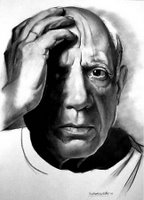
 Promiscuous Picasso, Lord Byron the philanderer, Dylan Thomas the boozy womaniser: these were not simply bonking Bohemians, it seems, but artists doing what their genes told them to do. According to the researchers the greater the artistic endeavour, the larger the sexual appetites. (There are some obvious exceptions to this rule: Julio Iglesias once boasted that he had had sex with 3,000 women, but has never yet sung a decent song.)
Promiscuous Picasso, Lord Byron the philanderer, Dylan Thomas the boozy womaniser: these were not simply bonking Bohemians, it seems, but artists doing what their genes told them to do. According to the researchers the greater the artistic endeavour, the larger the sexual appetites. (There are some obvious exceptions to this rule: Julio Iglesias once boasted that he had had sex with 3,000 women, but has never yet sung a decent song.) When Andrew Marvell wrote To his Coy Mistress, he was speaking for all artists who sense Time’s wingéd chariot hurrying near, and want to get laid, a lot, before it runs them over:
When Andrew Marvell wrote To his Coy Mistress, he was speaking for all artists who sense Time’s wingéd chariot hurrying near, and want to get laid, a lot, before it runs them over:
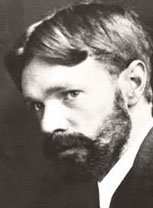 D.H Lawrence
D.H Lawrence
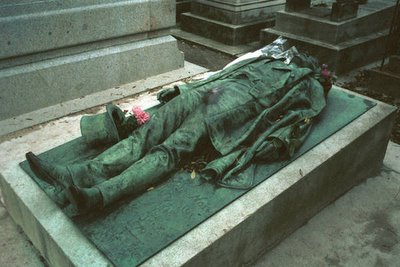
Who has been described both as a 'supercollector' and as 'the most successful art dealer of our times'.
Looking ahead in 100 years time, how do you think British art of the early 21st century will be regarded? Who are the great artists who will pass the test of time?
CS: General art books dated 2105 will be as brutal about editing the late 20th century as they are about almost all other centuries. Every artist other than Jackson Pollock, Andy Warhol, Donald Judd and Damien Hirst will be a footnote.

Luc Tuymans is considered one of the most significant and influential contemporary painters working today. He is one of the key figures of a new generation of figurative painters who have continued to paint during a time when many believed the medium had lost its relevance. In the context of the new information age, many artists felt that painting was a deeply conservative form of expression which did not match the heterogeneous nature of contemporary experience. Tuymans' work specifically addresses the challenge of the inadequacy and 'belatedness', as he puts it, of painting.
Tuymans was born in Antwerp, Belgium in 1958 and began to study fine art in 1976. He concentrated on painting but in the early 1980s he lost faith in the medium and gave up for two years. During this time he worked as a film-maker, and when he returned to painting in the mid-1980s, he introduced new techniques such as cropping, close-ups, framing and sequencing, which remain key elements of his work today.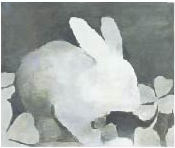
Tuymans' work is a vast repository of data, drawn from photography, television and film, combining a range of different styles and subject matter. His subjects range from major historical events, such as the Holocaust or the politics of the Belgian Congo, to the inconsequential and banal - wallpaper patterns, Christmas decorations, everyday objects There are also paintings which express abstract emotional states, titled 'Embitterment' or 'Insomnia', which imply existential or philosophical responses to the human condition.
Tuymans' range of imagery deliberately resists categorisation. Events and ideas are not expressed explicitly, but implied through subtle hints and allusions, creating an ambiguous collage of disconnected fragments and details. Tuymans has extended this approach in the exhibition hang at Tate Modern. He has chosen to present individual paintings from various bodies of work, bringing together disparate images from different points in his career. This approach signals Tuymans' belief that representation can only be partial and subjective, and meaning must be pieced together, like memories, through isolated fragments.
**Lincoln Park Lagoon:
color photograph
It was in October of last year, I was walking (exercising) after having a gluttonous meal at Mona Ami Gabi (a Bistro on Lincoln Park West). I headed east toward Lincoln Park and then North. I was living near Addison and Broadway at the time. Anyway, I happened upon a ringing cell phone. So foolishly I answered it.
"This is not my cell phone." I said to the caller.
"I know, I know." The caller said in a breathy voice. "I left that phone there because I need help. I need five dollars. Can you spare five dollars?"
I found the situation to be questionable, but I had had several cocktails and a half bottle of wine only moments earlier. The caller said that he needed the money put into a Dr. Pepper can that was hidden in the bushes a short distance down the path. I told the caller I could do it. He told me to put the phone back down on the ground where I had found it.
I went to the bushes where the can was supposed to be. Instead there were three thugs. They pulled me deeper into the bushes and one of them put duct tape across my mouth. Then they took my wallet. They all seemed to be getting quite a kick out of their exploits. One of them suggested they should strip me and leave me naked. So they did.
There I was, naked in Lincoln Park with duct tape on my mouth. I had to make my move. Taking the duct tape off my mouth almost took off my lips. Walking out from the bushes naked I came across a young man walking two very small dogs. He looked at me quizzically, but did not seem too surprised. "I was mugged." I told him. They took my clothes."
He laughed. Finally he took off his white T-shirt revealing a finally defined torso with a six pack and pecs to make any gym rat drool. I put the t-shirt on, but it didn't stretch far enough down to cover the essentials. He suggested I put my legs through the arms and wear it like shorts. I did, thanked him and made it home.
The next day I took my camera and photographed the crime scene. I showed the pictures of the crime scene to my friend who could only remark - "Wow this is really a nice picture."
That picture is this picture.
Courage
photograph
One day, without explanation, I took a piece of wood and painted a red hand on it. I started carrying it around looking for a place to take a picture of it.
I could have looked for interesting `touristy type spots', but instead I chose to focus on singular ideas, and tried to feel out a picture that would respond to that idea. The idea for this picture is courage. It was inspired by a quote I liked by Teddy Roosevelt:
"It is not the critic who counts, not the man who points out how the strong man stumbled, or where the doer of deeds could have done better. The credit belongs to the man who is actually in the arena, whose face is marred by dust and sweat and blood, who strives valiantly, who errs and comes short again and again, who knows the great enthusiasms, the great devotions, and spends himself in a worthy cause, who at best knows achievement and who at the worst if he fails at least fails while daring greatly so that his place shall never be with those cold and timid souls who know neither victory nor defeat."
Now, when I look at this picture, I think about that thought – but another viewer looking at the same picture might think about something totally different. If I tell them about my intention it does not guarantee their acceptance of it. But on the other hand, unless I tell them of my intention they might never have shared that thought.
`And some of them learned boy's shoes
boy's shoesboy's shoes:
photograph
This was taken after a pride parade, at one of those speaker's events held afterward in the park. The feet don't do this boy justice. He was beautiful. But I couldn't bring myself to take a picture of him. I got up next to him and played with my camera, and then seemingly accidentally, I took a picture of his feet. He noticed and smiled.
"Did you just take a picture of my shoes? he asked, still smiling but making his eyebrows arch in a questioning way.
"Yeah, I think so." I said. I called up the image to the screen on the back of the camera and showed it to him. He took the camera to get a better view. Just then I remembered the Buddhist `wish' chant, and slowly whispered: " Nam Myho Renge Kyo".
As if by magic he leaned towards me, bringing his face to mine, bringing his lips to mine, and putting one hand behind my neck, pulling me forward into his explorative kiss.
Then someone called out something, his name probably. He broke the kiss as though suddenly awakened from sleep. He gave me back the camera and said: " See you." And then he left.
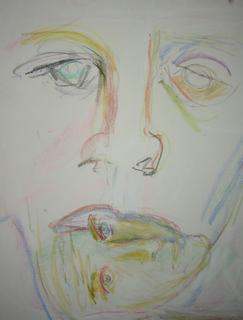 Words We dare not speak
Words We dare not speakWords we dare not speak
pastel on board
I met this high school kid who worked for me. He was quite unique. He was very innocent. And most importantly, he and I had the ability to read each others thoughts. I don't mean mind reading, I mean, more like, hyper fast anticipation of each others moves. I had never worked with a person quite like that before.
He was very straight. He told me early on that he thought a friend of his might be `turning'. I asked him what he thought about gays and he said his dad told him gay people were cool because you couldn't get them pregnant. (?) But still he didn't want his friend to `turn'.
He didn't know that I was gay at first, and after he was told by someone else, he asked me. I told him I was, and he seriously asked: "You're not going to attack me sometime are you?"
I was going through bit of depression at that time and had read about a weird technique whereby you try to continually mumble to yourself, until by accident, or chance, or fate or whatever - you come across the secret code of syllables that allow you to self combust.
One day my young friend asked me what I was saying when I talked to myself. I told him about the mumbling technique. He asked: "You want to kill yourself?"
I explained that self combusting using the technique was not technically killing yourself - you still could get a church burial.
He looked at me with a both serious and sad face and said in a gentle voice: " Man it would be negative for me if you did that."
So I stopped.
boy with a rubber band
Pastel and Ink
This is a picture of an autistic boy named Donny. He was in my group (B2 Boys) when I worked at Misericordia (Devon & Ridge). He was not one of the staff's favorites because of his habit of splatter painting rooms with his feces. He was disobedient, rebellious, and had a very bad temper. (This was on top of being a very low functioning autistic child.)
One day I caught him with a rubber band. It was the type of thing that a girl uses to tie up their hair. The kids, of course, were not supposed to have anything that they might swallow. I saw him playing with it peacefully. He had it stretched between two fingers and then in a repetitive motion he pulled it back- two long pulls followed by one short pull. He did this over and over, quite pleased with himself. I went over to him and gently took the rubber band away. He screamed a mind piercing bellow. I was in such shock by his cry that I tried to give him back the stupid rubber band. But he didn't want it. He stood and stormed away crying. I felt really bad.
On my last day at work, my co-workers threw a party for me. Sometime during the cake and lemonade Donny attached himself to me lower leg. I pretended not to notice. Before I left I made a point of looking in every room saying "Donny, where are you? Donny, where are you?" Finally at the end of my shift two other workers pried him off of me. He didn't scream. He just scurried away.
He didn't have a family. He was a ward of the state. His future prospects weren't good. And though he could be a little tyrant, there was something quite loveable about him.
 # 10 Phenomenon of Rising
# 10 Phenomenon of RisingPhenomenon of Rising
1' 8" wide by 1' 4" tall
There is a phenomena in the shared mythological psyche of all people, where a hero is captured or oppressed and seems to be in a state
of living death until it seems all is lost when miraculously they are saved.
 Knight riding backward
Knight riding backwardKnight riding backward
pastel on board
I gave my friend Eric this picture (after he asked me for a picture). He returned it the next day saying it just wasn't right. He said that he felt there was something seriously wrong with me if I thought he and his cheerleader wife would like it. He asked if I could just do a picture of a sailboat or a race car for him.
Eric and I grew up neighbors. We ended up at different colleges, and when we met years after graduating, I could see how much he had changed. And it wasn't just the fact that he was married. It was as though he had become serious (and I hadn't). I know that I blamed his wife for this unfortunate turn of events
My friend Nancy took a photograph of this picture to her psychic who reported that the real meaning of the picture was the little man on the horse in the bottom right hand corner riding backward. That, the psychic said, represents the animus of the artist. Your friend, she said, must ask if his energy is helping or hurting his old friend. And then he must ask himself why he feels the way he does.
I decided maybe I should avoid Eric (and Nancy) and focus more on my work and let the past float away behind me.
I personally have no idea what the meaning of this picture is.
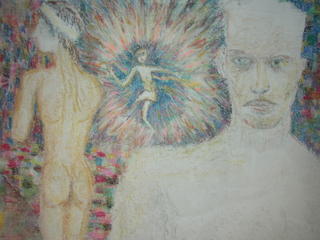
Shiva on my shoulder
pastel on board
When I was in school I started studying Hinduism in a comparative religion class. I even went to some Hindu temples. Somewhere along the line, probably because of my constitution, the God Shiva decided to hang out with me.
Some people believe that they have an angel on one shoulder and a devil on the other, both whispering into their head differing instructions. I have it worse. Shiva is the destroyer. And ever since Shiva decided to play with me, my life has been in chaos.
For example, I was driving on Lake Shore when this car filled with Albinos pulled up next to me. Their window rolled down and two of them stuck their bleach white heads out at me – taunting me. Then they were pointing a gun at me and taking pot shots at my front tire. They hit the car but not the tire and peeled out ahead of me. Consciously I knew I should not pursue – but Shiva gave the orders. I was going about 120 when a cop ended up on my tail with lights flashing and a bullhorn instructing me to pull over.
The cops wanted to know if I had been drinking or doing drugs – both of which I denied. One of the cops mentioned that my story didn't seem plausable because the bullet holes in the front panel of my car had already begun rusting – so it couldn't have just happened.
Luckily the cops got an emergency call, something about a blue van and a code 420. So they instructed me to drive slower and to head home. When I arrived home I locked my keys in my car- both my house and car keys. I was sitting on the back porch having a pity party for myself when a black and white striped cat walked up ( I live on the third floor.) The cat walked right past me and started clawing at my door. I told the cat I was locked out, but it continued pawing. So I got up and tried the door again. Surprise, surprise – it was open.
Later the cat wanted to sleep in bed with me – under the covers! I knew I had no choice. In the morning the cat was gone, and on the side of the bed where the cat had slept was a t-shirt (not one that I owned) that was soaked in blood.
Such is my life with Shiva on my shoulder.
 # 16 Boys on a raft
# 16 Boys on a raftBoys on a raft
pencil on paper
There is a difference between falling in lust and falling in love.
There was this guy named Adam. His family used to have a summer home in Michigan near my families place. I met Adam, who was my age, probably when we were six. And from then on I saw him for one week a year until I was fifteen.
There was a river near where we stayed and there was an island in the middle of the river. And sometime around when we were nine we built a raft. And we used that same raft, which we would improve every year, for the next six years as our mode of travel to the island. And sometimes we would just raft down the river and stop here or there to explore.
We were very competitive. Often a playfully splash would turn into a `live or die' wrestling match. We always got over our fights though because we were the only two young people around.
We would do stupid things together. We would try to catch animals- especially snakes to taunt each other with. We liked to make fires and tell weird stories to each other. He was actually a little bit better in every way then me. He was stronger, taller, had better reach, better balance, was a better swimmer, and according to him a better student. I had him beat only in looks. J
We found this deep part of the river where there was a tree close enough to dive from. So we started from the low branches to drag the day out, and ascended by useable branches upward. We got, I tell people, close to the clouds. He told me that his branch had been weak and it was too dangerous for me to try and top him. But I couldn't have stopped that part of myself that had something to prove - not just to him - but also to myself.
The branch broke and I fell like Icarus from the sky. My fall entailed passing through, or being hit by all of the branches below. When I hit bottom I had broken six bones - my nose, my left arm, my right leg, two ribs, and the small toe on my left foot. We were way down the river in a deserted area and I needed an ambulance. Adam just picked me up and got me on the raft. He paddled the thing back which took forever. I was in shock and I think I passed out a bit.
But I clearly remember that after we got back to our little landing - instead of going up to the parents for help, he carried me in his arms. I woke up in his arms. That was our last summer together.
Sometimes when I dream about him my heart actually aches.
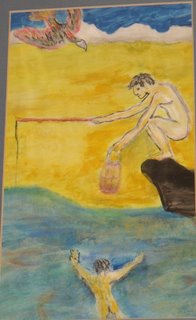
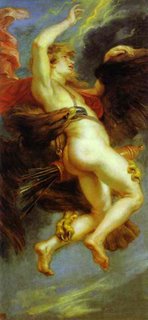

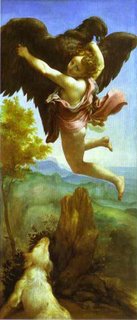 This by Correggio. The Abduction of Ganymede. c.1531-1532. Oil on canvas. The Louvre, Paris, France. Absolute beautiful use of color.
This by Correggio. The Abduction of Ganymede. c.1531-1532. Oil on canvas. The Louvre, Paris, France. Absolute beautiful use of color.
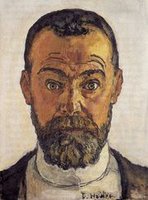
While doing some research on the Swiss painter Ferdinand Hodler (1853-1918) I came across an artical aimed at Oncologist (Cancer doctors) that Hodler made of his beloved Valentine Godé-Darel before, during, and after her illness. Below are the highlights of this unusual subject.
In January 1914, only 3 months after the birth of their daughter, Pauline, Godé-Darel had an operation for a gynecologic cancer, from which she died 1 year later. Between 1912 and 1915, Hodler painted her many times. He documented her wasting and eventual extinction without mercy and yet with intense sympathy. He created a series of paintings that force the viewer to face the process of dying. It may be helpful to an oncologist to sense his or her reaction to these visual stages of suffering. Figure 1, the youth. This portrait in shades of red from 1912 shows Godé-Darel as a beautiful, healthy young woman.




 Above is the agony. One day before her death, the patient has lost consciousness. The mouth is wide open; one imagines hearing a loud rattle. During this phase, it becomes impossible to communicate with the dying person. If it lasts a long time, death usually comes as a relief for the family and the nursing staff.
Above is the agony. One day before her death, the patient has lost consciousness. The mouth is wide open; one imagines hearing a loud rattle. During this phase, it becomes impossible to communicate with the dying person. If it lasts a long time, death usually comes as a relief for the family and the nursing staff.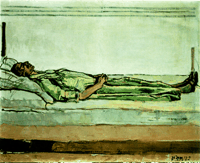 This is the last painting of the dead Godé-Darel. In this painting, made on January 26, 1915, day after her death, Hodler symbolically transforms the image. It is dominated by many horizontal lines. The blue stripes at the top appear to symbolize heaven, where the soul will disappear. The dark base of the bed points to an underground world. The header and the footer of the bed do not seem to be made of wood. Rather, the two brushstrokes may symbolize the measures of time, the beginning and the end.
This is the last painting of the dead Godé-Darel. In this painting, made on January 26, 1915, day after her death, Hodler symbolically transforms the image. It is dominated by many horizontal lines. The blue stripes at the top appear to symbolize heaven, where the soul will disappear. The dark base of the bed points to an underground world. The header and the footer of the bed do not seem to be made of wood. Rather, the two brushstrokes may symbolize the measures of time, the beginning and the end.

 I found her `artist explination' in an online magizine called Walrus.
I found her `artist explination' in an online magizine called Walrus.
Not actual size
Will be auctioned on Ebay starting today, ending next Sunday. We will see how this goes.




Artist note:
On the picture: Suffering for Us:
As the country recovers from the disaster in New Orleans, we sometimes forget the suffering going on in other parts of the world, whether that be our soldiers or civilians.
The Abu Ghraib Prison is a shameful testament to human cruelty. Hooded, humilified, in some cases sadistically tortured and sexually abused- this was done all in our name.
The people who committed crimes upon the prisoners, did so as representatives of us.
We share in the guilt.
This little picture is just a reminder. By reflection on the darkest of humanity, sometimes, we appreciate the goodness in our lives, and the needto do something in positive directionto help make the world a better place.
-paul grant Memorial Day 2005
*If you would like an 8 x10 print of this for $10.00 please email me at zenseeds@gmail.com
(Thanks for supporting the arts)